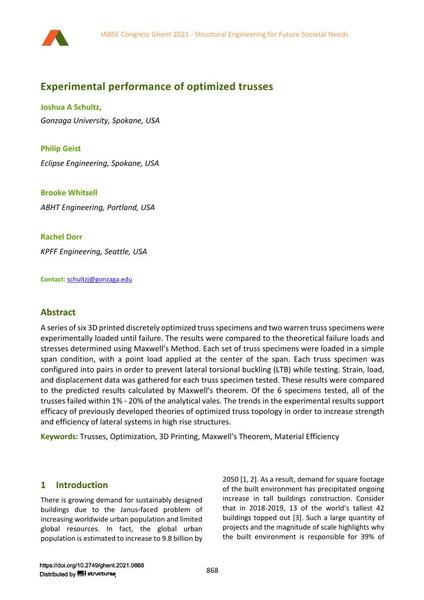Experimental performance of optimized trusses

|
|
|||||||||||
Bibliographic Details
| Author(s): |
Joshua A. Schultz
(Gonzaga University, Spokane, USA)
Phillip Geist (Eclipse Engineering, Spokane, USA) Brooke Whitsell (ABHT Engineering, Portland, USA) Rachel Dorr (KPFF Engineering, Seattle, USA) |
||||
|---|---|---|---|---|---|
| Medium: | conference paper | ||||
| Language(s): | English | ||||
| Conference: | IABSE Congress: Structural Engineering for Future Societal Needs, Ghent, Belgium, 22-24 September 2021 | ||||
| Published in: | IABSE Congress Ghent 2021 | ||||
|
|||||
| Page(s): | 868-876 | ||||
| Total no. of pages: | 9 | ||||
| DOI: | 10.2749/ghent.2021.0868 | ||||
| Abstract: |
A series of six 3D printed discretely optimized truss specimens and two warren truss specimens were experimentally loaded until failure. The results were compared to the theoretical failure loads and stresses determined using Maxwell’s Method. Each set of truss specimens were loaded in a simple span condition, with a point load applied at the center of the span. Each truss specimen was configured into pairs in order to prevent lateral torsional buckling (LTB) while testing. Strain, load, and displacement data was gathered for each truss specimen tested. These results were compared to the predicted results calculated by Maxwell’s theorem. Of the 6 specimens tested, all of the trusses failed within 1% - 20% of the analytical vales. The trends in the experimental results support efficacy of previously developed theories of optimized truss topology in order to increase strength and efficiency of lateral systems in high rise structures. |
||||
| Keywords: |
optimization trusses 3D printing material efficiency Maxwell’s Theorem
|
||||
| Copyright: | © 2021 International Association for Bridge and Structural Engineering (IABSE) | ||||
| License: | This creative work is copyrighted material and may not be used without explicit approval by the author and/or copyright owner. |
||||
